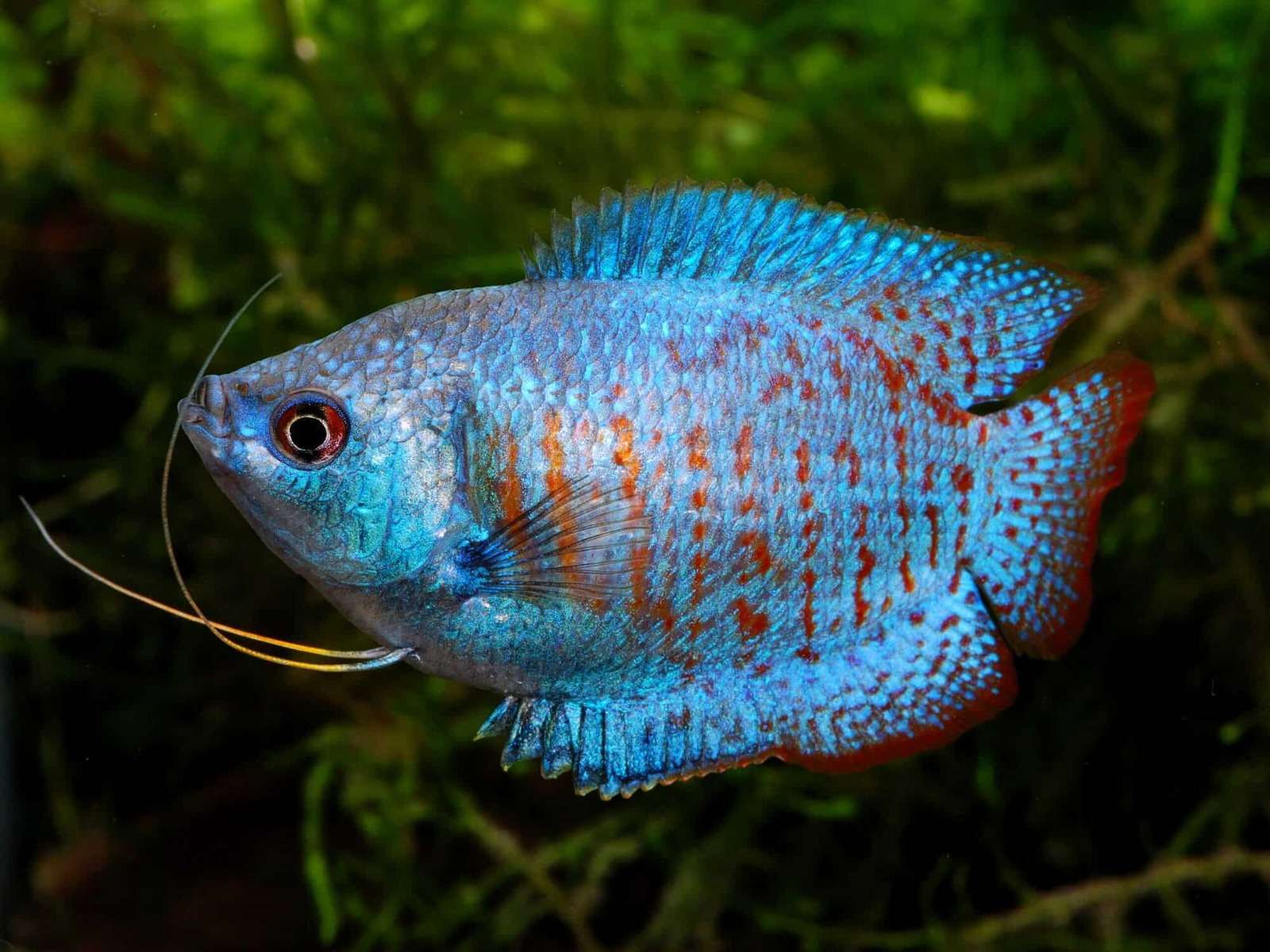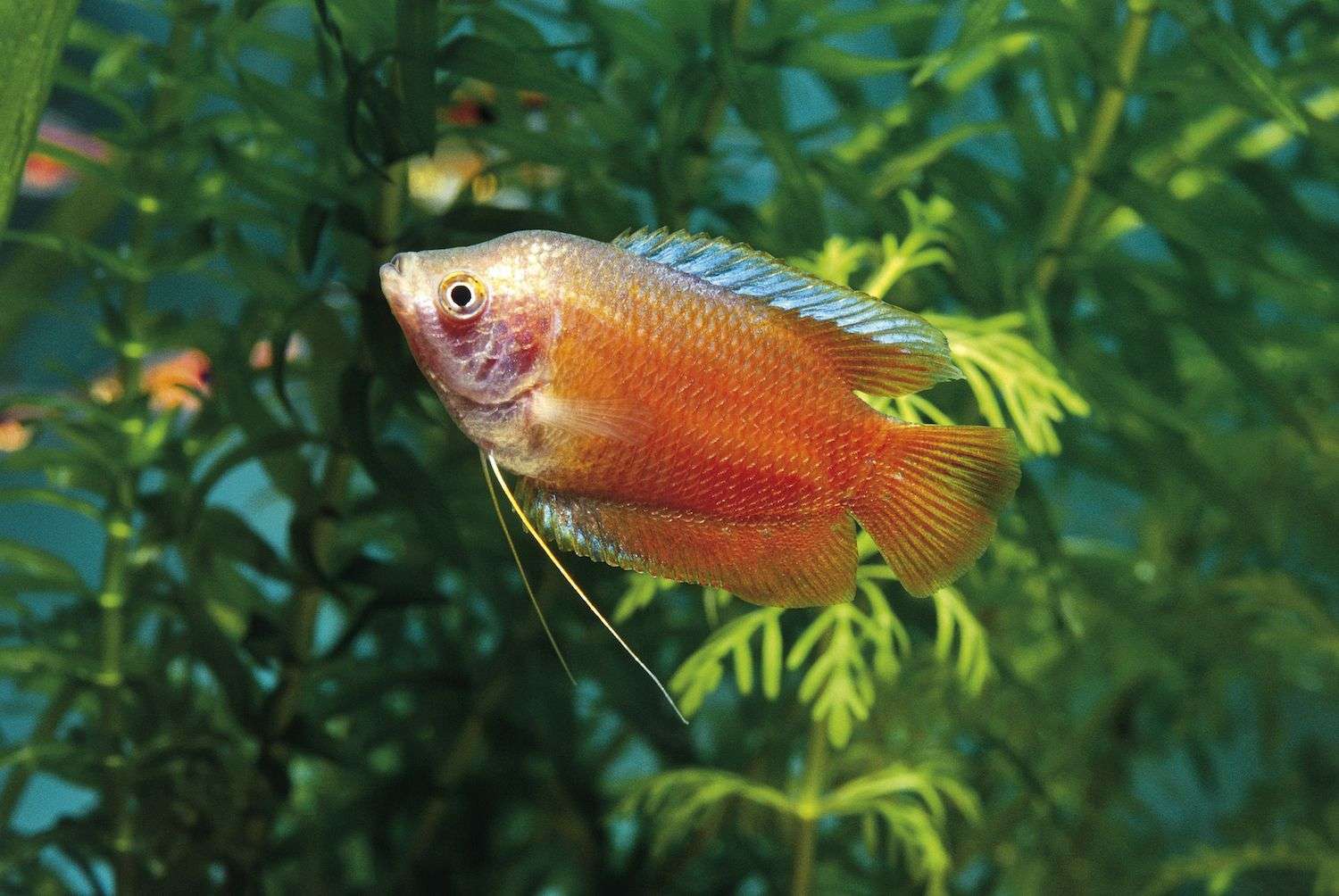Are Gouramis Schooling Fish

Introduction
Are Gouramis Schooling Fish: Gouramis, popularly known for their vibrant colors, graceful movements, and distinct personalities, are a group of freshwater fish that have intrigued aquarium enthusiasts for many years. One of the questions that often arises in the world of aquarists is whether gouramis are schooling fish. This question delves into their social behavior, a topic of great interest to those who seek to create thriving and harmonious aquatic communities within fish tanks.
The Osphronemidae family includes many types of gouramis, such as the Blue, Pearl, Dwarf, and Paradise Gouramis. Gouramis are commonly misclassified as “schooling fish” due to their solitary behavior, despite their outwardly friendly demeanor. While tetras and minnows are social fish that prefer to live in groups, gouramis have a reputation for being either solitary or possessive.
However, this generalization is incomplete. While not strict schoolers, gouramis can be social. Pearl Gouramis may like to swim in pairs or small groups, especially during breeding. To maintain a healthy gourami population in your aquarium, you must understand their behavior, species-specific features, and temperaments.
We’ll explore gouramis’ social dynamics, individual traits, and aquarium interactions. This knowledge will help aquarists choose tankmates and enrich these fascinating aquatic companions.

What gouramis can be kept together?
Gouramis Behavior/Compatibility
Male gouramis have a tendency to be aggressive towards each other, so they should typically be kept individually. Female gouramis usually tolerate each other well. Mixing different species or color varieties of gouramis should only be done in larger, well decorated tanks.
The species, tank size, and temperaments of gouramis determine their aquarium compatibility. Selecting the proper gourami species mix is essential for a peaceful aquatic community.
If given enough hiding places and territories, Pearl Gourami (Trichopodus leerii) and Dwarf Gourami (Trichogaster lalius) are more likely to live together. These species may even school occasionally, making the tank look better.
Keep territorial or aggressive gouramis like Betta splendens alone. Same-species males suffer considerably.
Gouramis need a large tank with hiding spots, suitable water, temperature, and feed. Prepare to separate fish if they fight or stress.
Different gourami species and personalities effect aquarium compatibility. A well-designed tank, careful observation, and research are needed to keep gouramis together and produce a lovely aquatic display.
A tank can contain how many gouramis?
Most gouramis thrive in groups of four or more with one male (or none). Many gouramis thrive in groups of six or more, but four is a decent start if you want tankmates.
The best amount of gouramis in an aquarium depends on their species, tank size, and attitude. Goramis are not schooling fish, however the correct group size can improve their health.
Pearl and Honey Gouramis are less aggressive and more social, so pair them or group them of three to five. These numbers can relieve stress and imitate their natural social behavior, which includes breeding and foraging.
Betta (Siamese Fighting Fish) are territorial and violent, although gouramis, especially males, get along. A bunch of aggressive gouramis could cause strife if kept together.
Tank size affects the amount of gouramis that can be kept together. How many gouramis to keep together varies on the species and tank size and configuration. To create a healthy gourami community, research the species and observe their behavior in the aquarium.
Good community fish: gouramis?
Gouramis are colorful, hardy, and friendly community tank residents.
Gouramis are good community aquarium fish depending on species and tank arrangement. Less social gouramis should be kept in species-specific aquariums or alone.
Honey and Pearl Gouramis are social fish. They like tetras, barbs, and danios. Their social activity in small groups or pairs can make the aquarium intriguing.
In congested tanks or during breeding, gouramis can become territorial. Provide enough shelter, vegetation, and territory to reduce conflict.
But aggressive gouramis like the Betta (Siamese Fighting Fish) are territorial and violent, especially to other gouramis, making them unsuitable for community tanks.
Gouramis can be communal fish depending on species, tank size, and arrangement. Gouramis enhance a community aquarium’s beauty and diversity, but they require planning, study, and behavior monitoring.
A novice can learn aquarium care using a range of beginner fish species. Celestial peal danios, golden dwarf barbs, neon tetras, pygmy Corydoras, guppies, betta fish, and dwarf gourami are good starter fish.
Beginners may not like gouramis for these reasons:
Water Quality: Temperature, pH, and ammonia affect gouramis. Beginners may struggle to maintain consistent water conditions, which can stress and injure fish.
Aggression: Betta gouramis are territorial and aggressive, which can cause problems if not regulated. Experience is needed to understand their social dynamics and tankmate compatibility.
Depending on species, gouramis have different dietary and environmental needs. Beginners may find it difficult to provide sufficient plants and hiding locations.
Disease Susceptibility: Beginners may struggle to identify and cure gourami illnesses.
These species tolerate water parameter changes well and are easier to care for. After learning the basics of aquarium maintenance, beginners can try keeping gouramis.
Can I have 2 gouramis?
Keeping multiple male anabantoids together in the same aquarium is usually risky. However, a lot depends on the size of the tank, the species and how it has been set up. The ideal male to female ration for any type of gourami is one male to at least two females. Three females per male is even better still.
Certainly, you can have two gouramis in your aquarium, but there are a few important considerations to keep in mind. Gouramis are a type of freshwater fish known for their vibrant colors and unique personalities. While it is possible to keep two gouramis together, there are some guidelines to ensure their well-being.
First, choose the right species of gouramis. Some species, like the Dwarf Gourami, are more peaceful and suitable for community tanks, while others, like the Betta or Paradise Gourami, can be more aggressive and territorial. It’s important to avoid mixing two aggressive species as they may become hostile towards each other.
Second, consider the size of your tank. Gouramis are social fish, but they also need their space. Ensure your aquarium is large enough to provide separate territories for each gourami to establish their own territories without feeling overcrowded.
Finally, keep an eye on them and be ready to separate them if aggression arises. While certain species of gourami can live harmoniously together, others may not. Keep an eye on how they’re getting along and have a plan ready in case separation is necessary to keep things calm in the tank.
Are Gouramis schooling fish?
In common perception, gouramis are not schooling fish. Depending on the species and individual, they are more likely to be solitary or semi-aggressive. While some species can tolerate conspecifics (members of the same species) in the same tank, they do not form tight schools like some other species of fish.
While tetras and danios are commonly thought of as schooling fish, gouramis are not. Although they may live in a communal tank with other fish and even show signs of social behavior, they prefer to be alone.
It’s not uncommon to see small groups of wild Dwarf Gouramis (Trichogaster lalius) and other Gourami species interacting with one another. Housing fish in groups of three or more creates a more natural environment and reduces antagonism.
However, larger Gourami species like the Pearl Gourami (Trichopodus leerii) tend to be more territorial and solitary. They may not tolerate the presence of other Gouramis in the same tank, especially during breeding seasons.
Ultimately, the social behavior of Gouramis can vary depending on the specific species and individual personalities. It’s important for aquarium enthusiasts to research and understand the specific requirements and behaviors of the particular Gourami species they wish to keep in order to provide an optimal and stress-free environment for these beautiful fish.
Can I keep multiple Gouramis in the same tank?
Yes, you can keep multiple Gouramis in the same tank, but it depends on the species, tank size, and the individual personalities of the fish. Some Gourami species are more territorial and aggressive than others, so careful consideration of compatibility is essential to prevent aggression.
Keeping multiple Gouramis in the same tank is possible, but it requires careful consideration of the species and the tank setup. Gouramis can be territorial, especially during breeding seasons, so it’s essential to choose compatible species and provide enough space and hiding spots.
Dwarf Gouramis (Trichogaster lalius) are a kind of Gourami that thrives when kept in groups. They thrive in community tanks with other peaceful fish of similar size.
However, larger Gouramis like the Pearl Gourami (Trichopodus leerii) tend to be more solitary and territorial. They may not tolerate other Gouramis in the same tank, especially if it’s not large enough to accommodate their individual territories.
Before introducing multiple Gouramis, carefully research the specific species and their social behaviors. Provide plenty of hiding spots, plants, and open swimming areas to reduce potential conflicts. Regular monitoring and observation will help ensure a harmonious environment for all the fish in the tank. Be ready to physically separate people if aggression becomes a problem.
Are there exceptions among Gourami species when it comes to schooling behavior?
Some species of Gourami, though typically found in schools, do not display this behavior. Although many gouramis have a reputation for being shy and territorial, some do exhibit a gentler side. The Dwarf Gourami (Trichogaster lalius) is a popular example because it is considered to be one of the friendliest of the gourami species. They like to gather in small groups in the wild, and their captive populations thrive when exposed to a wide variety of fish species.
Larger Gouramis, such as the Pearl Gourami (Trichopodus leerii), are not as gregarious and prefer to spend their time alone. It’s possible they wouldn’t get along with the other fish in a community tank, especially during breeding season.
Not all Gouramis are social, and some may do well in a tank with only members of their species, while others may do better in a more natural environment. By adapting the tank configuration to the individual demands of the Gourami species, aquarists may create a thriving and happy aquatic environment.

Conclusion
The question of whether gouramis are schooling fish is not a straightforward one. While gouramis are not strict schoolers in the traditional sense, their social behavior is more complex than a simple “yes” or “no” answer. It is essential for aquarists to recognize the diversity among gourami species and their individual temperaments.
Some gouramis, such as the Pearl Gourami, may exhibit a propensity for limited social interactions, often swimming in pairs or small groups during specific periods like breeding. However, other species, like the Betta, are more solitary and territorial, preferring to live alone. The level of social behavior can also depend on the tank environment, water parameters, and the presence of other fish.
Understanding these nuances is crucial for creating a harmonious and thriving gourami community in your aquarium. By selecting suitable tankmates and providing adequate hiding places and territories, aquarists can ensure the well-being of their gouramis. Observing their behavior and responding to their unique needs will lead to a more successful and enjoyable fishkeeping experience.
Gouramis may not be classic schooling fish, but they do exhibit a spectrum of social behaviors, making them fascinating and rewarding additions to any aquarium. By appreciating their individuality and respecting their preferences, aquarists can create an environment where these enchanting aquatic companions can flourish and captivate the observer with their elegance and charm.



